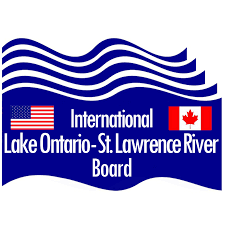Lake Ontario falls below the low water level threshold

Lake Ontario water levels have decreased and fallen below the Criterion H14 threshold giving the International Lake Ontario – St. Lawrence River Board the authority to begin implementing deviations from plan-prescribed flows. In accordance with the International Joint Commission (IJC) Directive and the Supplementary Order of Approval (December 8, 2016), the regulation plan needs to be followed until water levels reach any of the defined triggers, in this case low Criterion H14 threshold: “In the event that Lake Ontario levels reach or fall below extremely low levels, the works in the International Rapids Section shall be operated to provide all possible relief to municipal water intakes, navigation and power purposes, upstream and downstream.” The deviation strategy is authorized by the IJC’s Directive.
As of this writing, there have been no known or reported impacts to municipal water intakes or hydropower production. The Seaway Corporations and the Board are closely monitoring lower than average water levels both upstream and downstream of the Moses-Saunders Dam. Given these water level conditions, the Board has directed that Lake Ontario outflows the week beginning September 24 be set 3,532 cubic feet per second below the flow specified by Plan 2014.
Lake Ontario water levels fell 0.4 inches below the applicable low Criterion H14 threshold for the end of week. Threshold limits change weekly and are generally decreasing by 1.18 inches per week at this time of year. Lake Ontario water levels have also been dropping about 1.18 to 1.57 inches per week which is near the average seasonal decline, and water levels remain within the historical fluctuation range. The historical average (1918-2021) for this time of year is 245.24 feet. The historical minimum for this week was recorded in 1934 when the water level measured 242.55 feet.
The water levels of Lake Ontario and the upper St. Lawrence River are mostly dependent on the amount of water entering the system both from the local basin and the inflow from Lake Erie. The probabilistic forecast that is updated every week by the Board has consistently shown a likelihood of water levels dropping below average and possibly reaching the low Criterion H14 threshold. As a result, the Board has continued to monitor water levels in anticipation of Lake Ontario water levels decreasing to a point at which the low Criterion H14 threshold would be triggered to allow the International Lake Ontario-St. Lawrence River Board to implement deviations.
Although regulation of the outflows and deviations from the regulation plan may result in small increases to the lake levels in certain situations, the levels over the next six months will mostly depend on precipitation, evaporation, and non-controlled inflows from the upper Great Lakes. There is no method currently available to reliably forecast precipitation more than a few weeks into the future and thus decisions that are made by the Board can only be based on the most up to date current information.
The Board will continue to monitor conditions and the effects of the deviation strategy closely while simultaneously tracking weather forecasts.
Lake Ontario outflow changes are updated and available at https://ijc.org/en/loslrb/watershed/outflow-changes.
Provided information




